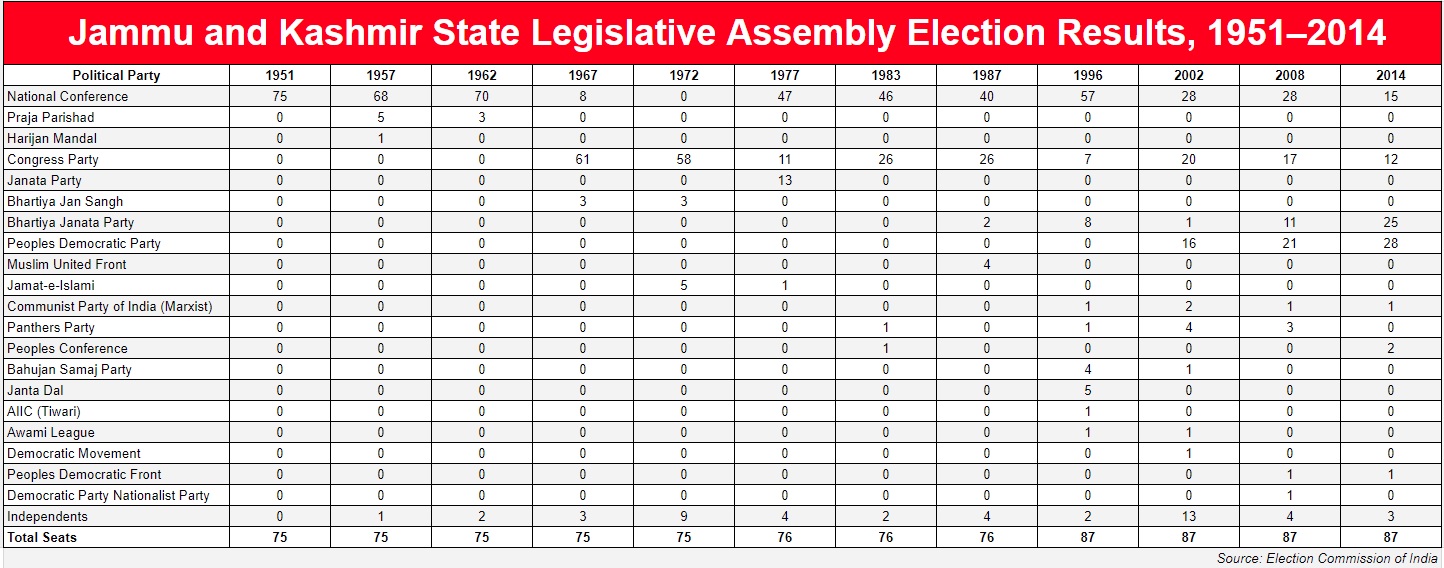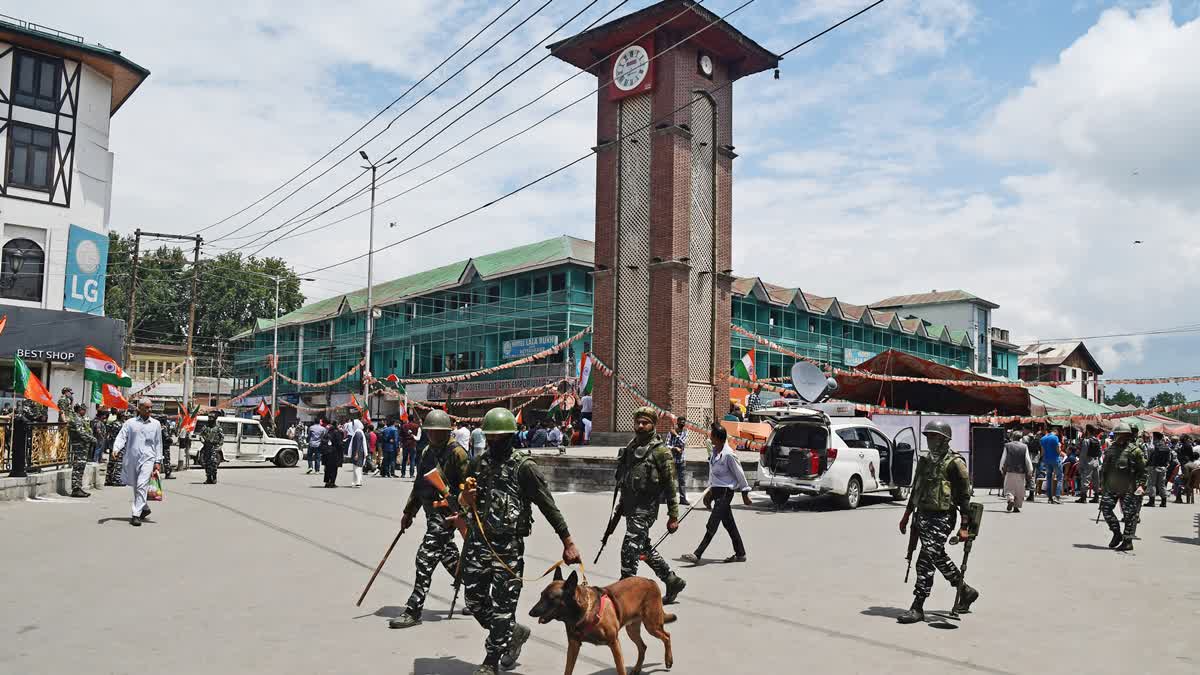Srinagar (Jammu and Kashmir): While Jammu and Kashmir is preparing for its first assembly elections since the abrogation of Article 370 and since 2014, the region's political landscape has undergone dramatic changes since its first elections in 1951. This evolution reflects a history of democratic development, shifting alliances, and significant constitutional shifts. Here's a comprehensive look at the major milestones in the region's electoral journey.
End Of Dogra Monarchy Heralds Dawn Of Democratic Governance: 1951
Following over a century of Dogra monarchy in Jammu and Kashmir, the erstwhile state held its first elections for its Constituent Assembly in 1951, a pivotal moment in framing the region's constitution. Under the leadership of Sheikh Abdullah, the National Conference (NC) secured a dominant position. This election was critical in establishing the region's early democratic framework. The position of Prime Minister, held by Abdullah, was later re-designated as Chief Minister, reflecting changes in political nomenclature and governance structures.
1953: Political turmoil ensued when Sheikh Abdullah was dismissed by Sardar Patel, then the Home Minister of India. The dismissal led to the appointment of Bakshi Ghulam Mohammad as the new Prime Minister. This period marked a shift in power dynamics and a realignment of political forces.
1963: The political environment became increasingly volatile due to the controversial issue of the "Mirpur Thana" controversy, which further strained relations between the regional government and the central authorities.
1964: The appointment of Ghulam Mohammad Sadiq as Chief Minister followed the dismissal of Bakshi Ghulam Mohammad. Sadiq's tenure was marked by efforts to stabilize the political environment and address the grievances of various factions. His tenure laid the groundwork for future political developments.
The Rise of Political Forces and Key Agreements: 1960s–1980s
1967: The assembly elections resulted in a hung verdict, with the National Conference emerging as the largest party but lacking an absolute majority. This led to the formation of a coalition government involving the Indian National Congress (INC) and other smaller parties, highlighting a fragmented political landscape.
1972: Syed Mir Qasim of the Indian National Congress became Chief Minister. His tenure was characterized by efforts to bridge the gap between the regional government and the central authorities, leading to significant political negotiations and agreements.
1975: Sheikh Abdullah returned to power following the Indira-Sheikh Accord. This accord was a landmark agreement between then-Prime Minister Indira Gandhi and Sheikh Abdullah, aimed at addressing regional grievances and restoring political normalcy. Abdullah's return marked the resurgence of the National Conference in J&K politics.
1977: The elections saw the National Conference securing a clear majority under Sheikh Abdullah. This victory ended the period of coalition governance and restored the NC's dominance in the region's politics. The election results underscored the party's strong support base and its ability to secure a majority in the assembly.
1986: The Rajiv-Farooq Accord, an agreement between Prime Minister Rajiv Gandhi and Chief Minister Farooq Abdullah, aimed to restore political stability and address regional unrest. However, the 1987 elections were marred by allegations of widespread rigging, fueling growing discontent and contributing to the rise of militancy in the region.
The Political Landscape: 1980s–2000s
1982: Dr Farooq Abdullah, son of Sheikh Abdullah, became Chief Minister. His tenure was marked by efforts to maintain stability amidst growing unrest and rising militancy.
1984: Ghulam Mohammad Shah, known as "Gul Shah," succeeded Farooq Abdullah in a controversial move. His brief tenure was characterized by political instability, leading to Abdullah's return to power.
1990–1996: The imposition of President's Rule, the longest period of direct central administration in J&K's history, reflected severe security challenges and a breakdown in regional governance.
1996: Farooq Abdullah returned to power following the end of President's Rule. The elections, conducted under challenging conditions, saw Abdullah's NC secure a majority, signaling a partial return to political normalcy.
The Emergence of New Political Forces: 2000s–Present
2002: The rise of the Peoples Democratic Party (PDP), led by Mufti Mohammad Sayeed, marked a significant shift. The PDP formed a coalition government with the Indian National Congress (INC), reflecting a new political configuration aimed at addressing regional issues and fostering cooperation.
2005: Ghulam Nabi Azad of the Congress became Chief Minister in a coalition with the PDP. His tenure, marked by efforts to address regional grievances and implement development initiatives, was cut short by the Amarnath land row, leading to the collapse of the coalition.
2008: The elections resulted in a hung assembly. The National Conference's Omar Abdullah formed a coalition government with the Congress, continuing the trend of coalition governance in a fragmented political environment.
2015: Mufti Mohammad Sayeed of the PDP formed a coalition government with the BJP. His tenure, which focused on regional development, was interrupted by his sudden death in 2016.
2016: Mehbooba Mufti, Sayeed's daughter, succeeded as Chief Minister, becoming the first woman to hold the office. Her tenure faced challenges from increasing political tensions and security issues. The BJP’s withdrawal of support in 2018 led to the imposition of Governor's Rule.
2019: A landmark event in Jammu and Kashmir’s history was the abrogation of Article 370, which led to the reorganization of the region into two Union Territories—Jammu & Kashmir and Ladakh. This constitutional change marked a significant shift in the region’s political and administrative structure.

Jamaat-e-Islami (JMI): A significant socio-religious organization in Jammu and Kashmir, it has influenced regional politics and was a part of the political landscape in the 1980s.
Harijan Mandal: Focused on the rights and upliftment of Scheduled Castes and Scheduled Tribes, this organization contributed to the region's social and political movements.
Muslim United Front (MUF): Formed in the late 1980s, MUF was a coalition of various Muslim parties challenging the dominance of the National Conference and Congress, reflecting the growing political assertiveness of the Muslim community.
Bharatiya Janata Party (BJP): The BJP has increasingly influenced Jammu and Kashmir’s political landscape, especially in the Jammu region, impacting voter preferences and regional dynamics.
Longest-Ruling Politicians
Sheikh Abdullah: Known as the "Lion of Kashmir," Sheikh Abdullah, and his National Conference dominated the early political landscape, significantly shaping the region's governance and policies.
Farooq Abdullah: His leadership, marked by periods of stability and challenges from rising militancy, continued to influence Jammu and Kashmir’s political environment.
Leadership over the decades
- Sheikh Abdullah (1947-1953): Sheikh Abdullah, the founding leader of the National Conference, was the first Prime Minister of Jammu and Kashmir, a role he later transitioned to Chief Minister. He played a pivotal role in the early political developments of the state, establishing the National Conference as a dominant political force.
- Ghulam Mohammad Sadiq (1964-1971): Ghulam Mohammad Sadiq succeeded Bakshi Ghulam Mohammad to become the first Chief Minister after the renaming of the state. His tenure marked a significant period in the state's political history, with efforts to consolidate regional governance.
- Syed Mir Qasim (1972-1975): Leading the Indian National Congress, Syed Mir Qasim worked diligently to bridge the gaps between the Central government and regional leadership. His efforts were instrumental in facilitating the return of Sheikh Abdullah to political prominence.
- Sheikh Abdullah (1975-1982): Sheikh Abdullah's return to power in 1975 signified a revival of the National Conference’s influence in the state. His tenure was marked by attempts to restore and strengthen the party's position in Jammu and Kashmir.
- Farooq Abdullah (1982-1984, 1986-1990, 1996-2002): Farooq Abdullah, the son of Sheikh Abdullah, held the Chief Minister's office on three separate occasions. His leadership significantly impacted the political landscape of Jammu and Kashmir, navigating through periods of both stability and unrest.
- Ghulam Mohammad Shah (1984-1986): Known as "Gul Shah," Ghulam Mohammad Shah briefly led the state amid political unrest. His tenure was characterized by instability, which ultimately led to the restoration of Farooq Abdullah's government.
- President's Rule (1990-1996): The region was placed under President's Rule due to escalating militancy, marking the longest period of direct central administration in its history. This period was a response to severe security challenges and the breakdown of regional governance.
- Farooq Abdullah (1996-2002): Following the end of President's Rule, Farooq Abdullah resumed leadership amidst ongoing militancy. His return marked a partial return to normalcy and efforts to stabilize the region.
- Mufti Mohammad Sayeed (2002-2005): As the leader of the Peoples Democratic Party (PDP), Mufti Mohammad Sayeed's tenure was notable for the rise of his party and the formation of a coalition government with the Congress. His leadership focused on addressing regional issues and fostering political cooperation.
- Ghulam Nabi Azad (2005-2008): Ghulam Nabi Azad led a Congress-PDP coalition government. His term was marked by efforts to address regional grievances and implement development initiatives, though it ended controversially with the Amarnath land row.
- Omar Abdullah (2009-2015): The youngest Chief Minister at the time, Omar Abdullah faced significant challenges, including the unrest of 2010. His tenure was marked by efforts to address political and security issues in the state.
- Mufti Mohammad Sayeed (2015-2016): Returning to power in 2015, Mufti Mohammad Sayeed led a coalition government with the BJP. His term was cut short by his sudden death in early 2016, which ended a period of relative stability.
- Mehbooba Mufti (2016-2018): Mehbooba Mufti, the first woman to hold the office of Chief Minister, faced numerous challenges during her tenure. Her term ended with the withdrawal of support from the BJP, leading to the imposition of Governor's Rule.
- Governor's Rule and Lieutenant Governor's Administration (2018-Present): Since the imposition of Governor's Rule in 2018 following the abrogation of Article 370, Jammu and Kashmir has been governed by various two Lieutenant Governors - GC Murmu (October 31, 2019 – August 6, 2020) and Manoj Sinha (August 7, 2020 – Present).



